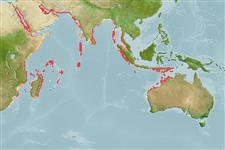>
Ovalentaria/misc (Various families in series Ovalentaria) >
Pomacentridae (Damselfishes) > Pomacentrinae
Etymology: Amblyglyphidodon: Greek, amblys = darkness + Greek, glyphis = carved + Greek, odous = teeth (Ref. 45335); indicus: Name from Latin 'indicus', of India, for its geographical distribution which is confined to the Indian Ocean and adjacent Red Sea..
More on authors: Allen & Randall.
Environment: milieu / climate zone / depth range / distribution range
นิเวศวิทยา
เกี่ยวกับทะเล,น้ำเค็ม เกี่ยวกับหินโสโครก; ระดับความลึก 2 - 15 m (Ref. 46206). Tropical
Indian Ocean: from the Gulf of Aqaba, Red Sea, the Maldives to the Andaman Sea, off northern tip of Sumatra at Weh I, (Indonesia) and coast of Thailand.
ขนาด / น้ำหนัก / Age
Maturity: Lm ? range ? - ? cm
Max length : 8.3 cm SL เพศผู้/กระเทย; (Ref. 28618)
เงี่ยงครีบหลัง (รวม): 8; ก้านครีบอ่อนที่หาง (รวม): 11-13; เงี่ยงครีบก้น 2; ก้านครีบอ่อนที่ก้น: 13 - 14; สัตว์มีกระดูกสันหลัง: 26. This species is distinguished by the following characters: D XIII,11-13 (usually 12); A II,13 (rarely 14); pectoral rays 17-18; tubed lateral-line scales 15-18; gill rakers 7-8 + 18-20 = 25-28); body depth 1.5-1.7 in SL; teeth incisiform and in a single row; scaled suborbital; predorsal scales extending well before the nostrils, nearly to base of upper lip; colouration silvery grading to yellowish white on the belly and lower sides; the back and dorsal part of head is mainly green; with a broad, vertically elongate greenish streak on each body scale; rear edges of preopercle and upper half of opercle are dusky grey; median fins translucent to greenish white, the lower and upper edge of caudal fin narrowly blackish; pelvic fins pale yellow to white; pectoral fins are translucent with small dark spot at base of uppermost rays (Ref. 82240).
Presumed to be reef-associated (Ref. 206). Found in shallow waters on branching Acropora corals of inshore and outer reefs. Dead branches of corals serve as nests (Ref. 90102). Oviparous, distinct pairing during breeding (Ref. 205). Eggs are demersal and adhere to the substrate (Ref. 205). Males guard and aerate the eggs (Ref. 205). Distribution allopatric except eastern Andaman Sea where its similar species A. leucogaster is rarely found (Ref. 90102).
Life cycle and mating behavior
วัยเจริญพันธุ์ | การสืบพันธุ์ | การวางไข่ | เซลสืบพันธ์ของเพศเมีย(ไข่) | ความดกของไข่ | ตัวอ่อน
Oviparous, distinct pairing during breeding (Ref. 205). Eggs are demersal and adhere to the substrate (Ref. 205). Males guard and aerate the eggs (Ref. 205).
Allen, G.R. and J.E. Randall, 2002. A review of the leucogaster species complex of the Indo-Pacific pomacentrid genus Amblyglyphidodon, with descriptions of two new species. aqua, J. Ichthyol. Aquat. Biol. 5(4):139-152. (Ref. 82240)
IUCN Red List Status (Ref. 130435)
Threat to humans
Harmless
Human uses
ข้อมูลเพิ่มเติม
ชื่อสามัญชื่อพ้องกลไกการเผาผลาญพลังงานผู้ล่าการศึกษาเกี่ยวกับผลกระทบของสารประกอบทางเคมีที่เป็นอันตรายต่อสิ่งมีชีวิต ประชากร และสิ่งแวดล้อมการสืบพันธุ์วัยเจริญพันธุ์การวางไข่การรวมกลุ่มวางไข่ความดกของไข่เซลสืบพันธ์ของเพศเมีย(ไข่)Egg development
อ้างอิงการเพาะเลี้ยงสัตว์น้ำประวัติการเพาะเลี้ยงสัตว์น้ำสายพันธุ์พันธุศาสตร์ElectrophoresesอัตราพันธุกรรมโรคการแปรรูปNutrientsMass conversion
ผู้ร่วมมือรูปภาพหลายรูปStamps, Coins Misc.เสียงปลามีพิษ เช่น ปลาปักเป้าความเร็วรูปแบบการว่ายน้ำพื้นที่เหงือกOtolithsสมองวิสัยทัศน์
เครื่องมือ
Special reports
Download XML
แหล่งที่มาจากอินเตอร์เน็ต
Estimates based on models
Preferred temperature (Ref.
123201): 24.8 - 29.1, mean 27.4 °C (based on 464 cells).
Phylogenetic diversity index (Ref.
82804): PD
50 = 0.5005 [Uniqueness, from 0.5 = low to 2.0 = high].
Bayesian length-weight: a=0.02344 (0.01149 - 0.04783), b=2.99 (2.82 - 3.16), in cm total length, based on LWR estimates for this (Sub)family-body shape (Ref.
93245).
ระดับชั้นอาหาร (Ref.
69278): 2.7 ±0.3 se; based on size and trophs of closest relatives
ความสามารถในการกลับคืนสู่ปกติ (Ref.
120179): ความสูง, เวลาต่ำสุดที่จะทำให้ประชากรเพิ่มขึ้นเป็น 2 เท่าใช้เวลาน้อยกว่า 15 เดือน (Preliminary K or Fecundity.).
Fishing Vulnerability (Ref.
59153): Low vulnerability (10 of 100).
Nutrients (Ref.
124155): Calcium = 137 [67, 217] mg/100g; Iron = 0.815 [0.488, 1.381] mg/100g; Protein = 18.1 [16.9, 19.3] %; Omega3 = 0.111 [0.064, 0.185] g/100g; Selenium = 20 [11, 39] μg/100g; VitaminA = 102 [28, 348] μg/100g; Zinc = 2 [1, 3] mg/100g (wet weight);
